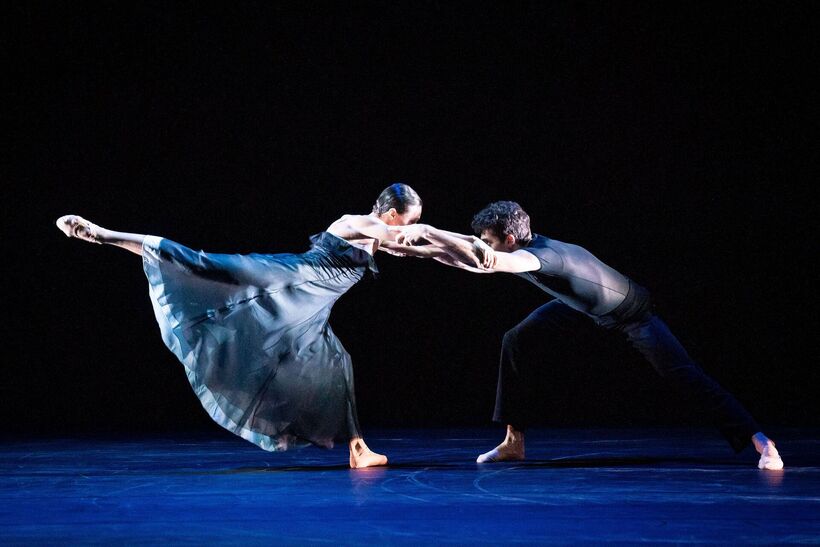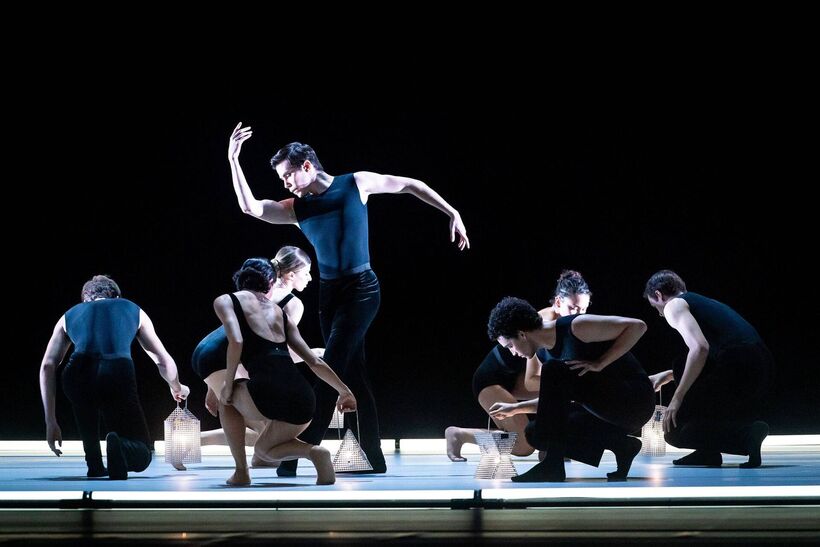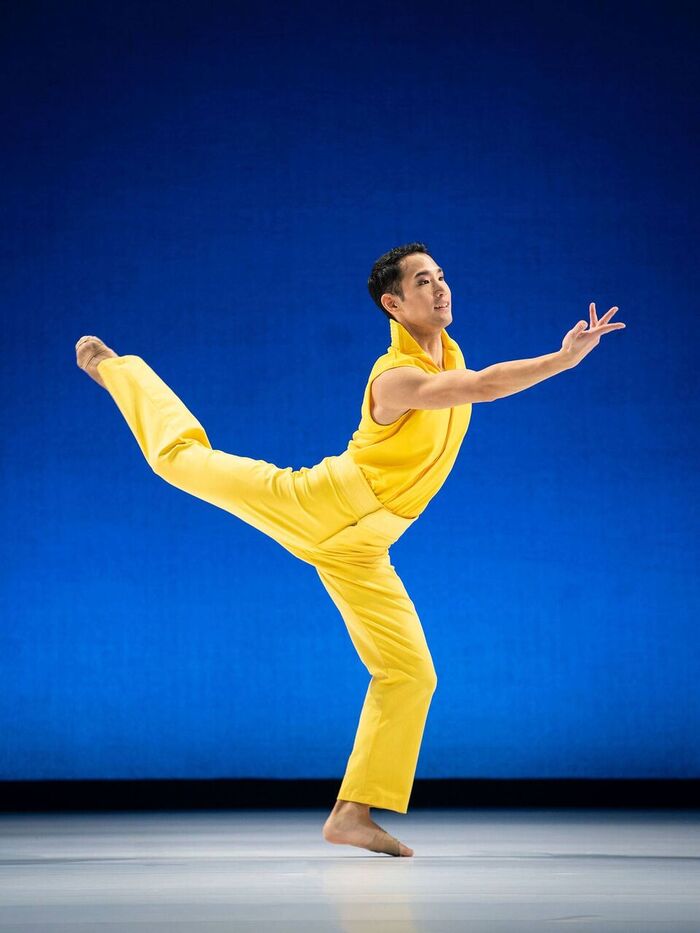The Moon Wears a White Shirt – Vienna’s Classical Ballet Company Enchants with a Versatile Triple Bill
In an admirable move, the Vienna State Ballet dedicated its latest triple bill to those who rarely get the limelight: the corps de ballet. They don’t disappoint: the ensemble proves just as colourful as the work of three modern masters which we are able to enjoy throughout the night.
Vienna Volksoper’s new ballet evening received the attention-grabbing title The Moon Wears a White Shirt; what a difference to the uninspired titles that the Hungarian State Opera tends to give to its ballet evenings, such as Frenetic Dance or Classical Bravura, to name a few from this season alone. Ironically, the catchy Viennese title has Hungarian roots - it is a quote from a poem by Sándor Weöres, one of the most important and popular Hungarian poets of the 20thcentury. Of course, a triple bill is not only hard to name but also hard to compile in such a way that it is exciting and diverse enough, and yet retains a thread which links the programme pieces together. In this case, this common thread seems to be the high level of musicality and the mysterious atmosphere that only moonlit nights can create.
The evening opened with Martin Schläpfer’s Drittes Klavierkonzert (Piano Concerto No.3.), set to Alfred Schnittke’s music. Swiss-born Schläpfer has been ballet director and chief choreographer of the Vienna State Ballet since 2020. Before that, he led companies such as the Bern Ballet, Balletmainz, and the Ballet am Rhein Düsseldorf Duisburg – the latter was named ‘company of the year’ three times during his leadership by the German journal tanz. He has created more than 80 pieces of choreography for his ensembles across the world, often working with symphonic music or reimagining classical ballets. Schläpfer rarely stages his older work in new settings – the Schnittke piece, originally created some 23 years ago, is one of the few exceptions.

The stage floor is bathed in blue light, and the back wall’s blackness is broken only by a narrow strip of glittering stars that slowly rises throughout the piece, indicating the passing of time. A woman stands alone on stage – the ballet follows her life’s journey, told not through events, but rather through encounters and connections. Figures come and go; sometimes they stay on stage motionless, half hiding behind the side curtains, watching the woman from afar; sometimes they surround her, drag her along, abandon her. And there are more and more bodies lying around on stage – probably gone from this life forever. Schläpfer’s enthusiasm for Schnittke’s music is tangible throughout the piece – the outstretched arms, long arabesques, and quick dynamic changes on one hand, soft, fluid movements on the other, following the dramatic ebb and flow of the music perfectly. Apart from protagonist Mila Schmidt, it is Keisuke Nejime who impresses most with his energy and his high, smooth jumps.
American choreographer Karole Armitage has been called a rebel, a provocateur and a punk ballerina, among other things. She danced at the companies of legendary creators George Balanchine and Merce Cunningham, then choreographed music videos for the likes of Madonna and Michael Jackson, which made her a star but also a bit of an outcast in both the ‘serious’ dance and pop culture scenes. In her work, she daringly mixes styles, from ballet through to modern to folk dance. Her 2007 piece, Ligeti Essays, is set in a dream landscape: a single, bare silver tree (designed by Armitage’s longtime collaborator, David Salle) stands in one corner of the stage, serving as a reference point in the space for the unfolding solos, duets, and quartets which make up the choreography. Armitage has chosen three song cycles by Hungarian composer György Ligeti, all adaptations of Sándor Weöres’ poems. The choreographer didn’t want to illustrate the words, but rather capture and reflect on the feeling of the music, which is full of contradictions: romance, anger, pride, joy, and sorrow are all present in these songs. Accordingly, the movement ranges from lyrical to sharp, from athletic to lean, never missing the sudden changes and unexpected accents of the music and using every opportunity to add a little comedy to the choreography. The last song cycle is made up of wedding dances, and so the onstage mood becomes increasingly celebratory, peaking in a circle dance which includes the whole cast. The dancers deliver the material with precision and a good sense of humour – they seem tobe having a lot of fun, and so is the audience.

The evening concludes with Dandelion Wine by American modern dance legend Paul Taylor, set to music by Italian Baroque composer Pietro Locatelli. The deep blue of the stage from the first act returns, but this time, it serves as the clear, bright sky over this light-hearted piece from 2000. The dancers, clad in white with colourful petticoats and belts – to remind us of a flower meadow – engage in a series of joyful dances in different constellations. It all reminded me of a summery village scene of a romantic ballet, only with less spectacular, more grounded choreography. This piece seems a bit old-fashioned and uninspired next to the inventiveness of the other two, and the dancers also struggle at times with the pace, the formations, and even the steps. And yet, based on the enthusiastic cheers, the notoriously conservative Vienna audience considered it to be the perfect ending to the night.

It was an altogether well-programmed, diverse, and enjoyable evening that made me a little sad that Martin Schläpfer is leaving his post as Viennese ballet director at the end of August 2025. On the other hand, who wouldn’t be excited about the arrival of Alessandra Ferri to the post – the Italian prima ballerina and former principal at the Royal Ballet, American Ballet Theatre, and La Scala, who, at 60, is still actively performing major roles around the world? The stars are still glittering brightly in the sky above Vienna.
Written from the performance of the 22 November 2023 in Volksoper Wien
The Moon Wears a White Shirt
Drittes Klavierkonzert
Music: Alfred Schnittke
Choreography: Martin Schläpfer
Musical direction: Christoph Altstaedt
Set and costume design: Thomas Ziegler
Light design: Alex Brok
Coach: Yuko Kato
Ballet master: Vesna Orlić
Piano: Alina Bercu
Dancers: Mila Schmidt, Gabriele Aime, Vivian de Britto Schiller, Kristina Ermolenok, Olivia Poropat, Marta Schiumarini, Una Zubović, László Benedek, Riccardo Franchi, Kevin Hena, Dragos Musat, Keisuke Nejime, Aleksandar Orlić, Francesco Scandroglio
Ligeti Essays
Music: György Ligeti
Choreography: Karole Armitage
Musical direction and piano: Christoph Altstaedt
Set design: David Salle
Costume design: Peter Speliopoulos
Light design: Clifton Taylor
Coach: Izabela Szylinska
Ballet masters: Vesna Orlić, Samuel Colombet
Singers: Stephanie Maitland, Annelie Sophie Müller, Birgid Steinberger
Percussion: Manfred Radner, Peter Dullnig, Dominic Feichtinger, Lucas Salaun
Wind: Agnes Bischof, Edoardo Blandamura, Isabella Krapf, Antonia Weber
Dancers: Tessa Magda, Olivia Poropat, Una Zubović, Riccardo Franchi, Aleksandar Orlić, Francesco Scandroglio, Felipe Vieira
Dandelion Wine
Music: Pietro Locatelli
Choreography: Paul Taylor
Musical director and pianoforte: Christoph Altstaedt
Costume design: Santo Loquasto
Light design: Jennifer Tipton
Coach: Richard Chen See
Ballet master: Sergey Ignatiev
Solo violin: Vesna Stanković
Orchestra of the Volksoper Wien
Dancers: Gabriele Aime, Dominika Ambrus, Vivian de Britto Schiller, Kristina Ermolenok, Riccardo Franchi, Dragos Musat, Keisuke Nejime, Olivia Poropat



